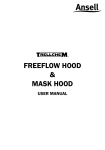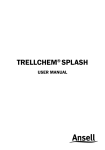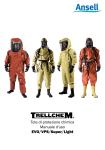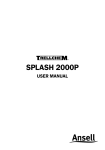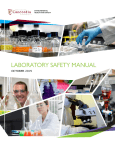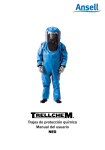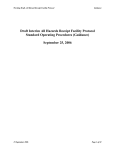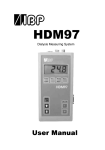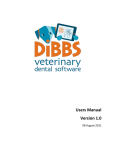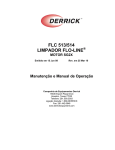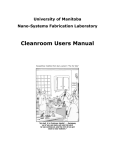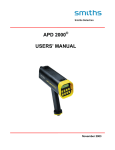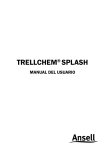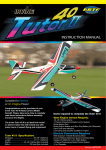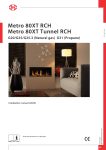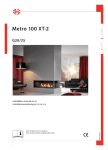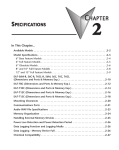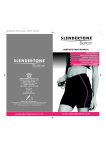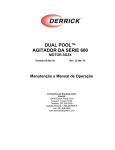Download Chemical protective suits User manual EVO/VPS
Transcript
Chemical protective suits User manual EVO/VPS-Flash/VPS/Super/Light 1 2 INDEX IMPORTANT!................................................................................................. 7 Certificates and approvals.......................................................................... 8 Description of suits........................................................................................................8 EC Type approval............................................................................................................................. 8 NFPA approval................................................................................................................9 Warranty..................................................................................................... 10 Markings on the suit................................................................................. 11 Symbols/Pictograms....................................................................................................11 Sizes............................................................................................................................. 12 Other............................................................................................................................ 12 Suit materials............................................................................................. 12 Components............................................................................................... 13 Zipper........................................................................................................................... 13 Gloves and glove attachment system........................................................................ 13 Footwear and attachments.........................................................................................14 Visor and face seal.......................................................................................................14 Ventilation system..................................................................................... 14 Freeflow system (only type 1c suits)........................................................ 15 Description.................................................................................................................. 15 Requirements - Air supply source...............................................................................16 Requirements - Airline hose........................................................................................16 Accessories (available on request).......................................................... 16 Visor protective lens (Tear-off/ATEX)...........................................................................16 Antifog lens...................................................................................................................16 Cold protection.............................................................................................................16 BA splash protection (type T suits)..............................................................................17 Kevlar® overgloves.......................................................................................................17 Undergarments.......................................................................................... 17 Safety considerations................................................................................ 17 Chemical response......................................................................................................17 Guidelines for use....................................................................................................... 18 Breathing apparatus .................................................................................................. 18 Temperatures.............................................................................................................. 19 Antistatic properties.................................................................................................... 19 Donning of suit........................................................................................... 21 Non-encapsulating 1b (type T) .................................................................................. 22 Encapsulating 1a (type TE/VP1/CV)...........................................................................27 Encapsulating 1c (type Freeflow)............................................................................... 32 Doffing of suit............................................................................................. 32 3 Storage instructions.................................................................................. 32 Environmental conditions........................................................................................... 32 Suit storage methods.................................................................................................. 33 Storage life/Shelf life.................................................................................................. 33 Inspection................................................................................................... 34 About the pressure test/test of gastightness......................................... 35 Trellchem® manual test equipment.......................................................... 36 Test of gastightness - procedure.............................................................. 37 Non-encapsulating type T (with Trelltest)...................................................................37 Non-encapsulating type T with attached mask (with Trelltest)................................ 39 Encapsulating type TE/VP1/CV/Freeflow (with Trelltest)..........................................41 Trellchem® automatic test equipment..................................................... 43 All suit types (with Trellchem® automatic test equipment)....................................... 44 Test of Freeflow system (flow check)....................................................... 48 Equipment................................................................................................................... 48 Procedure.................................................................................................................... 48 Repair and maintenance .......................................................................... 50 Repair of suit - general............................................................................................... 50 Repair of Trellchem® EVO/VPS-Flash/VPS.................................................................51 Repair of Trellchem® Super........................................................................................ 60 Repair of Trellchem® Light.......................................................................................... 65 Trellchem® Bayonet glove ring system - general....................................................... 70 Replacement of rubber cuffs..................................................................................... 72 Replacement of Viton®/Butyl & Nitrile/Chloroprene rubber gloves..........................74 Replacement of glove assembly (Ansell Barrier® inner glove plus outer rubber glove).....................................................................................76 Maintenance instructions - Bayonet rings................................................................. 80 Maintenance instructions - Zipper............................................................................. 80 Maintenance instructions - Face seal........................................................................ 80 Maintenance instructions - Rubber cuffs.................................................................. 80 Maintenance instructions - Gloves.............................................................................81 Maintenance instructions - Regulating valve and passthrough................................81 Maintenance instructions - Overpressure valve.........................................................81 Spare part list...............................................................................................................81 Cleaning..................................................................................................... 82 Decontamination guidelines..................................................................... 82 Volatile chemicals....................................................................................................... 83 Water soluble chemicals............................................................................................ 83 Acids and alkali.............................................................................................................................84 Water insoluble chemicals......................................................................................... 84 Chemical warfare agents............................................................................................ 84 Retirement and disposal........................................................................... 85 4 Technical data............................................................................................ 86 EC type approval data - mechanical data.................................................................. 86 EC type approval data - chemical data.......................................................................87 EC type approval data - components......................................................................... 89 Technical information - Freeflow suits........................................................................91 NFPA 1991 & EN 943 - Comparison...........................................................................91 Chemical permeation data......................................................................................... 92 5 6 IMPORTANT! This manual is valid only for Trellchem® EVO, VPS-Flash, VPS, Super and Light, types T, TE, VP1, CV and Freeflow. These suits may only be used by specially trained personnel who are familiar with the contents of this manual. Failure to comply with any of the recommendations given herein may result in serious injury or death. Please check http://protective.ansell.com to make sure you have the latest edition of this manual. 7 Certificates and approvals Description of suits This manual is valid for Trellchem® EVO, VPS-Flash, VPS, Super and Light in the following designs: • Type TE, VP1 and CV: Encapsulating suit, type 1a according to EN 943-1, which is designed for use with an SCBA worn inside the suit. • Type T: Non-encapsulating suit, type 1b according to EN 943-1, which is designed for use with an SCBA worn outside the suit. • Type Freeflow: Encapsulating suit, type 1c according to EN 943-1, which is designed for use with external air supply, i.e. airline. Not to be used with SCBA. The Trellchem® EVO, VPS-Flash, VPS and Super designs (not Freeflow) are also available in “ET” versions, i.e. versions certified for “Emergency Teams” according to EN 943-2. These suits have the following special features: Trellchem® HCR zipper with extra chemical resistance, inside hump protection and, if fitted with boots, these are certified firemen’s boots (according to EN 20345 and EN 15090). Trellchem® EVO, VPS-Flash, VPS, Super and Light type T (type 1b according to the European standard EN 943) shall be worn with Trellchem® Mini Hood or the TC Hood whenever there is a risk for splash of liquid chemicals. Trellchem® EVO, VPS-Flash, VPS, Super and Light also fulfil EN 14126, protection against infective agents and EN 1073-2, protection against radioactive particles. EC Type approval The suits are CE-marked and have EC type approval under the Council Directive 89/686/EEC on personal protective equipment and the European standard EN 943 part 1 and part 2 (ET versions). 8 Trellchem® EVO, VPS-Flash, VPS, Super and Light have been tested and approved by notified body no 0200; FORCE Certification A/S, Park Allé 345, DK-2605 Bröndby, Denmark. CERTIFICATE NUMBER DK-0200-XXXX (see table) SUIT TYPE CV/VP1 TYPE CV/VP1-ET TYPE T TYPE T-ET Trellchem EVO PPE-1814 PPE-1815 PPE-1819 PPE-1820 Trellchem VPS-Flash PPE-2059 PPE-2059 PPE-2060 PPE-2060 Trellchem VPS PPE-1972 PPE-1972 PPE-1884 PPE-1884 Trellchem Super PPE-2061 PPE-2061 PPE-2062 PPE-2062 Trellchem Light PPE-1942 - PPE-1943 - Trellchem® Super type Freeflow, certificate number DK-0200-PPE-1622. Trellchem® Light type Freeflow, certificate number DK-0200-PPE-1692. Type approval test results can be found in chapter “Technical data” below. NFPA approval Trellchem® EVO, and VPS-Flash type VP1 and CV (sock model) have been tested by Intertek Testing Services (Cortland, NY, USA) and comply with the American standard NFPA 1991, including the optional requirements for protection against ”Flash Fire” and ”Liquefied Gas” (condensed gas). They are certified by SEI (Safety Equipment Institute, USA). The certification includes the chemical and biological terrorism protection requirements. Cert. Mod. (NFPA 1991) 9 Warranty In case of faults or defects, if any, in the protective suits, including gloves and other accessories, the following is applicable: If a fault or defect appears in the protective suit as a result or in the course of any use, function or state of the protective suit, the purchaser is requested to contact the company from which the suit was purchased. The terms of sale agreed upon between the purchaser and the said company shall apply in this case. Ansell Protective Solutions AB shall have no liability to purchasers of the protective suits other than when the suit in question was purchased directly from Ansell Protective Solutions AB. The liability of Ansell Protective Solutions AB for faults or defects of a protective suit shall be subject to the Standard Warranty set forth in its General Conditions of Delivery, unless otherwise stated in a separate agreement in writing between Ansell Protective Solutions AB and the purchaser. The General Conditions of Delivery are available on request. This manual does not in any way comprise a guarantee or warranty on the part of Ansell Protective Solutions AB, and Ansell Protective Solutions AB expressly excludes any implied warranty of merchantability or fitness. Ansell Protective Solutions AB is not in any way nor under any conditions liable for compensation to the purchaser or commercial user of a protective suit for injury to (including death of) any person or loss of or damage to property of any kind or for costs, loss of profits or other damage or loss of any nature whatsoever. The warranty or product guarantee could never be prolonged by anything stated in this manual. 10 Markings on the suit Symbols/Pictograms This marking (CE-marking) indicates that the suit has EC type approval and complies with the Council Directive on Personal Protective Equipment 89/686/EC. Chemical protective clothing is category III according to the directive and 0402 is the number of the notified body that is responsible for production control. 0402 is SP, Sweden. This pictogram indicates that the suit offers chemical protection. This pictogram indicates that the suit offers protection against infective agents (EN 14126). This pictogram indicates that the suit offers protection against radioactive particles (EN 1073-2). This pictogram indicates that this manual has to be read. This pictogram indicates the size of the suit, see below. 11 Sizes The size of the suit is indicated by letters XS-XXL and by indicating the size of the user in a pictogram as above. Size range XS S M L XL XXL Height (cm) 164-176 170-182 176-188 182-194 188-200 200-212 Chest/bust girth (cm) 84-92 88-96 92-100 96-104 100-108 104-116 Other Marking on the suit can be made by a ”permanent marker” type of pen. Special labels/markings can be supplied upon request. Suit materials Trellchem® EVO is made from an aramid fabric coated with Viton®/butyl rubber on the outside and a polymer barrier laminate on the inside. This material construction is patented by Ansell Protective Solutions AB. Trellchem® VPS-Flash is made from an aramid fabric coated with chloroprene rubber on the outside and a polymer barrier laminate on the inside. This material construction is patented by Ansell Protective Solutions AB. Trellchem® VPS is made from a polyamide fabric coated with chloroprene rubber on the outside and a polymer barrier laminate on the inside. Trellchem® Super is made from a polyamide fabric coated with Viton®/butyl rubber on the outside and butyl rubber on the inside. Trellchem® Light is made from a PVC double coated fabric. (Viton® is a registered trademark of DuPont.) 12 Components Zipper Trellchem® suits are fitted with a heavy-duty gastight zipper, either the standard chloroprene coated zipper or, on ET versions, the extra chemical resistant Trellchem® HCR zipper. All suits are fitted with a zipper splash guard to protect the zipper against direct chemical splashes. Gloves and glove attachment system The suits are fitted with gloves that match the chemical protective properties of the suit material: For Trellchem® EVO, VPS-Flash and VPS there are two glove options: 1) The Trellchem® Viton®/Butyl rubber glove. 2) A system consisting of the Ansell Barrier inner glove and an outer rubber glove - either the Trellchem® NFPA chloroprene rubber glove or the Viton®/ Butyl rubber glove. For Trellchem® Super the standard glove is the Viton®/Butyl rubber glove. As an option any of the gloves/glove systems above may be used. For Trellchem® Light the standard glove is the Nitrile/Chloroprene rubber glove. As an option any of the gloves/glove systems above may be used. The gloves are attached with the Trellchem® Bayonet glove ring system. An outer knitted Kevlar® glove is available as an option to improve the mechanical resistance (e.g. cut resistance) of the gloves. 13 Footwear and attachments The suits are fitted with boots that match the chemical protective properties of the suit material: Trellchem® EVO, VPS-Flash, VPS and Super have black nitrile rubber safety boots, certified as Firemen’s boots, and Trellchem® Light has yellow PVC boots. The boots are attached with an ergonomically designed ring attachment. Alternatively the suit is equipped with an integral bootee (sock) in the suit material, to be used with a separate outer boot. Visor and face seal The visor is made from 2 mm impact resistant PVC with very good chemical resistance. The face seal is moulded in natural rubber, which gives a very smooth and tight fit around the face and to the face mask. Ventilation system Trellchem® EVO, VPS-Flash, VPS, Super and Light are as standard equipped with an internal ventilation system. The system is connected to the breathing apparatus (SCBA) via a regulating valve, which can be adjusted to give a flow rate of 0, 2, 30 or 100 litres/min. 2 litres/min is the normal flow rate which creates an overpressure in the suit to protect against sudden punctures. The air is distributed into the sleeves and legs via thin PVC hoses. Note: A flow rate of 30 or 100 litres/min will empty the SCBA quickly and is therefore only recommended to be used when connected to an external air supply, i.e. airline. The suit can be fitted with a special regulating valve with built-in airline passthrough upon request. Excess air in the suit is ventilated through overpressure valves; 1 pce on type T suits and 2 pcs on type TE/VP1/CV suits. 14 Freeflow system (only type 1c suits) Description The Trellchem® Freeflow system consists of: • A valve with an airline passthrough • Internal tubing • Two air diffusers/silencers • Two diffuser pockets • A warning whistle • An external hose fitted with a CEJN (”Euro”) female coupling for connection to an external air source. When in use the system shall be connected to an air source with 3-8 bars, which gives a minimum air flow of 220 l/min in the suit. The whistle will sound if the pressure goes below 3 bars and there is a risk that the minimum flow is not fulfilled. Excess air in the suit is ventilated through 4 overpressure valves. Check the function of the whistle by connecting the source of air via a pressure reducer and reducing the pressure. Make sure that the minimum flow through the suit is attained by connecting a flow meter to the diffusers. See ”Test of Freeflow system (flow check)” below for use of the flow meter. Note: The Freeflow suit is designed for use without helmet or with an industrial helmet of type MSA Super V-Gard. WARNING! If a helmet is used, make sure the helmet peak is not in direct contact with the suit visor during work. This may obstruct the airflow and cause an increase in the carbon dioxide level in the breathing zone. Technical information can be found in chapter ”Technical data”. 15 Requirements - Air supply source The air supply system, mobile or stationary, shall have a working pressure of minimum 3 bars and a maximum of 8 bars. The delivered air shall fulfil the requirements for breathing air according to EN 12021 and EN 132. Requirements - Airline hose The compressed air supply shall meet EN 14594 (replacing EN 270:1994) or 14593:1 (replacing EN 139). Length: 5-30 meters. A maximum of 3 separate hoses may be connected in series, using CEJN quick couplings, to obtain the required total length. Approved hoses are breathing air hoses with inner diameter of 10 mm such as the Factair SAH range and North A161250. Accessories (available on request) Visor protective lens (Tear-off/ATEX) Replaceable antistatic protective foil which is applied with tape on the outside of the visor. Protects the visor against scratches and helps to clear the visor quickly after a chemical splash. Antifog lens An antifog treated lens with a self-adhesive foamed gasket is attached on the inside of the visor to create a dry air column and thereby avoiding fogging of the visor. Alternatively an antifog gel is available for application on the visor (and on the manometer window on the leg, if fitted). This gel temporarily prevents the visor from fogging up and therefore should be applied repeatedly. Cold protection When responding to accidents that involve liquefied (condensed) gases at low temperature, great precautions must be taken. We recommend use of an outer cold protective cover like the TRELLCOVER, as well as an insulating underwear like the Trellchem® insulating underwear to protect the wearer from frost-bite of the skin, to protect the suit from becoming stiff and for better comfort. 16 BA splash protection (type T suits) TC Hood is used on type T suits to protect the breathing apparatus from chemical splash and provide extra leakage protection between mask and face seal. It is available with PVC visor (TC Hood) or face seal (TC Hood S). Kevlar® overgloves Cut protective gloves made of knitted Kevlar®, large enough to wear ontop of the rubber gloves, are available. Undergarments The most suitable type of undergarments depends on weather conditions and type of mission as well as the tactics and preferences of the user. For very cold weather and/or where there is a risk of contact with chemicals at very low temperature, insulating undergarments like the Trellchem® Insulating Underwear that protect the user from frost bite, should be used. Also, the Trellchem® suits can be worn ontop of firemen’s turnout gear. Note: Make sure you have the right size of suit depending on type of undergarment. Safety considerations All personnel should be well acquainted with this manual before using the suits. Chemical response Responding to hazardous chemical emergencies can be a very complex task and may involve chemicals other than those stipulated as test chemicals in standards (e.g. NFPA 1991 or EN 943) or in this documentation. Besides the specific chemical(s) encountered other aspects such as the concentration, temperature of the chemical, mixtures of chemicals, flammability, toxicity etc. have to be considered. Identify the chemicals before entering into the hazardous area in the chemical protective suit. Minimize the exposure to chemicals during the mission. Avoid direct contact with the chemicals as far as possible. 17 Guidelines for use Choosing the appropriate chemical protective suit, accessories and other necessary equipment to deal with a chemical emergency, has to be made by qualified safety professionals. The Trellchem® chemical protective suits (except Freeflow versions) are designed to be worn together with breathing apparatus combined with full face positive pressure breathing mask. Many types of work and work environments require the use of a helmet. Trellchem® suits can be used with a safety helmet. The Trellchem® chemical protective suits of sock design should be worn together with a outer safety boot with nailguard and steel toe cap. As an alternative there are suits with fixed safety boots. Make sure that someone is available to assist while donning, decontaminating and doffing. Also make sure that the suit is decontaminated, inspected and pressure tested before it is returned into service or storage. If the suit is damaged, take it out of service and repair or replace as required. Breathing apparatus For European users the breathing apparatus must be approved to EN 137. This includes a requirement (§ 6.15) for the regulator valve to have a design or position that it cannot be closed inadvertently. We recommend a breathing apparatus with a regulator valve that is designed in a way that an accidental turning of the valve alone is not sufficient to turn off the air. However, if the breathing apparatus to be used is equipped with a valve where fulfilment of § 6.15 has been achieved only by need of several full turns of the valve to close it, then the wearer should practice reaching the valve while wearing the suit. 18 Temperatures The suit may be used in temperature ranges from -40 °C till +65 °C. Never use the suit near open flames or intense heat. The risk of heat stress must always be taken into account when working in coveralls and encapsulating suits. Depending on the type of work and clothing this risk may be considerable even at moderate ambient temperatures. Great precaution must be taken when responding to accidents which involve condensed gases at low temperature. We recommend using TRELLCOVER, as well as an insulating underwear (see “Accessories”). Antistatic properties Trellchem® EVO and Trellchem® Super Trellchem® EVO and Trellchem® Super have been found acceptable for use in Dust Ex atmospheres of zones 20, 21 and 22 and in Gas Ex atmospheres of zones 0, 1 and 2 (EU directive 1999/92/EC) for chemicals in explosion groups IIA, IIB and IIC (IEC 60079) after evaluation according to EN 13463-1 and the ATEX Directive 94/9/EC. The evaluation has been performed by Dekra Exam GmbH in Essen, Germany. See further information regarding the visor, gloves and boots below. Trellchem® VPS-Flash Trellchem® VPS-Flash has been found acceptable for use in Dust Ex atmospheres of zones 21 and 22 and in Gas Ex atmospheres of zone 2 (EU directive 1999/92/EC) for chemicals in explosion group IIA (IEC 60079) after evaluation according to EN 13463-1 and the ATEX Directive 94/9/EC. The approval is further limited by the fact that the suit should not be used in/ near processes where strong electrostatic charges are generated such as filling Styrofoam into packaging or rolling plastic films on or off rolls. The evaluation has been performed by Dekra Exam GmbH in Essen, Germany. See further information regarding the visor, gloves and boots below. 19 Trellchem® EVO, VPS-Flash and Super - Visor, gloves and boots For the approval to be valid the suit has to be worn with the ATEX lens attached to the outside of the visor at all times. The user is reminded that any other equipment used together with the suit also has to be suitable for use in potentially explosive atmospheres. This includes boots for suits of sock version and any gloves worn on top of the Trellchem® Viton®/Butyl rubber glove or the Ansell Barrier® inner glove plus NFPA chloroprene rubber glove combination. The use of Trellchem® Kevlar over gloves is approved, however these gloves are not electrically conductive so e.g. hand held metal tools may require additional means of grounding. For added safety the suit may be sprayed with water before and during use. Trellchem® Light The Trellchem® Light suit material fulfils the EN 1149-5 §4.2.1 (material requirements for protective clothing with antistatic properties). Antistatic data on the suit material is provided in the Chemical and technical data chapter. Note: The data is only valid for the suit material. Important: This information is not a claim that the complete garment is antistatic or in any way safe to use with flammable liquids or vapours or explosive atmospheres. The European standard on antistatic properties of clothing, EN 1149, does not specify any method to evaluate a complete garment. If static charges are a concern the suit may be sprayed with water before and during use to minimise the risk of static charges accumulating. Trellchem® VPS The Trellchem® VPS is not approved to any standard for antistatic properties. If static charges are a concern the suit may be sprayed with water before and during use to minimise the risk of static charges accumulating. 20 Donning of suit Make sure that the suit is visually inspected, air pressure tested and free from defects. Have someone assist you while dressing. If outside, try to find a clean area to stand. Type T suits (not suits with glued-in mask) are delivered with a separate elastic band intended to be used inside the hood to get a tight fit of the face seal around the face. It is optional to use but it is recommended if the wearer has a small or narrow face. When fitted in the hood the elastic band makes it possible to adjust the fit of the face seal. Note: The elastic band shall be attached before the suit is donned. 2. Attach the band in the loops inside the hood, using the velcro closing. 1. The elastic band is shaped as a cross. Place the cross “upside down” inside the hood (sewn arrow pointing down). Note: There are three loop positions to be able to adjust the band in height to obtain an optimal fit, which is individual for each user. 21 Non-encapsulating 1b (type T) 1. Place both legs into the suit. Sock version: Put on the safety boots. 2. Put on the inner cotton comfort gloves, art. no. 072 240 200. Insert right arm into the right sleeve. 22 3. Insert the left arm into the left sleeve of the suit. 4. Put your head through the hood and push it down around your neck. Alternatively, pull the hood over your head and adjust the face seal. 23 5. Close the zipper and fold the flyfront over it. 6. Pull the hood over your head and adjust the face seal, if not done previously (step 4). 24 7. Put on the breathing apparatus, except the mask. 8. Connect the ventilation hose to the inlet-/regulating valve. 25 9. Put on the rubber gloves. See “Trellchem® Bayonet glove ring system”. 10. Put on the facemask and the helmet. Put on the facemask starting at the chin and make sure the facemask tightens against the face seal of the suit (not the suit material). Pull the harness over the head and tighten the straps. Have someone check the mask position and make sure there are no folds on the face seal, which can cause leakage. 26 Encapsulating 1a (type TE/VP1/CV) 1. Put both legs into the suit and put on the boots (sock version). 27 2. Put on the breathing apparatus except the mask. 3. Put on the inner cotton comfort gloves, art. no. 072 240 200. 28 4. Put right arm into the suit and hump over the breathing apparatus. 5. Insert your left arm into the left sleeve. 29 6. Connect the ventilation hose to the regulating valve. 7. Put on the breathing mask and safety helmet. 30 8. Pull the hood over your head and close the zipper. 9. Put on the rubber gloves. See “Trellchem® Bayonet glove ring system”. 31 Encapsulating 1c (type Freeflow) Make sure an inspection has been performed. Before use, make sure the source of breathing air is within the specified pressure range and that the minum flow is achieved, see ”Freeflow system” and ”Test of Freeflow system (flow check)”. Make sure you have someone to assist you when donning. • Connect the compressed air supply tube to the compressor so that the suit is supplied with air • Step into the suit with the legs first and put the arms into the sleeves of the suit • Adjust and fasten internal waist strap around your waist • Put your head into the hood • Close the zipper with support from your dressing assistant Doffing of suit After a response in hazardous environment the suit must be rinsed with water, preferrably containing detergent, before doffing. Make sure you have someone to assist you when doffing. Take off the suit in reverse order of that described above. Storage instructions Environmental conditions • Dry, humidity 50 ± 30% • Room temperature, 20 ± 5°C • Away from direct sunlight • Away from ozone-generating sources, for example electrical engines, fluorescent lamps and air-conditioners 32 Suit storage methods The suit should be stored: • Folded as upon delivery or hanging • In the plastic bag delivered with it or in another tight bag or box • If stored in a soft bag, never store suits on top of each other, as too much weight or high pressure may damage the visor • If stored in a box, make sure the box is large enough to easily accommodate the suit without pushing, pressing or squeezing it • If stored hanging, suits with boots should have the boots on the floor to avoid excess strain on the shoulders • If stored folded, the face seal on type T suits should be as flat as possible, avoiding sharp folds • The zipper should be almost closed with approximately 10 cm open Note: When stored the suit should be unfolded and inspected once a year. Storage life/Shelf life Trellchem® EVO: 10 years Trellchem® VPS: 7 years Trellchem® Super: 10 years Trellchem® Light: 7 years The storage/shelf life applies under optimal storage conditions (see above) and does not form a guarantee. The storage/shelf life may be exceeded or less than the above stated. Therefore the condition of the suit needs to be checked regularly to evaluate whether it is in good condition or not (see below). 33 Inspection The suit is to be inspected upon delivery, after each use and after repair or, if not used, once a year. The inspection shall consist of the following steps: • Visual inspection of both inside and outside. • Look for surface damages on material, seams, visor or face seal, boots, inner and outer gloves. • Look for changes in the material properties such as brittleness, stiffness, swelling, stickiness or other phenomena which could be evidence of chemical degradation or aging. • Check function of zipper and zipper fitting. See chapter ”Repair and maintenance”. • Check the function of inlet valve, exhaust valves and passthrough (if fitted). Make certain that they are firmly mounted and not damaged. • Pressure test/test of gastightness, see instructions below. Note any remarks, found during the inspection, in the inspection log. If any defect/malfunction is found, the suit must be taken out of service. Minor repairs may be done according to “Repair of suit”. Any repair or replacement of parts other than those described herein may only be performed by a certified Trellchem® dealer or by Ansell Protective Solutions AB. Chemical degradation is not possible to repair. 34 About the pressure test/test of gastightness Testing according to EN 943-1 and EN 464. The pressure test is conducted in three steps: 1. Inflate the suit with an airpistol through the valve on the face seal plate (type T suit) or through the valve on the adapter (type TE/VP1/CV suit) to a pressure of 1750 Pa/17.5 mbar/178 mm water column/7.0 inch water gauge. 2. Lower the pressure to 1700 Pa/17.0 mbar/173 mm water column/6.8 inch water gauge using the valve on the face seal plate/adapter. This is the pre-test expansion pressure. Maintain this pressure for 10 minutes, adding air if necessary. 3. Adjust the pressure to 1650 Pa/16.5 mbar/168 mm water column/6.6 inch water gauge. This is the test pressure. Set and start the timer and wait for 6 minutes. Do not touch the suit during this period of time. Note the pressure after 6 minutes. If this pressure is 1350 Pa/13.5 mbar/138 mm water column/5.4 inch water gauge or more, the suit has passed the test. Note the final pressure in the suit log. After the pressure test is completed disconnect the pressure gauge from the face seal plate / adapter, remove the plate / adapter, reinstall the exhaust valve (if removed) and remove the blind plug from the exhaust valve(s). If the suit does not pass this test, the suit shall be removed from service. Inflate the suit and brush it with soapy water to find the leaks. Repair the leaks according to the instructions under “Repair and maintenance”. Retest according to “Test of gastightness - procedure”. Final pressure reading is to be filled in after completed repair and retest in the inspection log. 35 Trellchem® manual test equipment The Trelltest pressure test kit consists of: 1 pce face seal plate with connection nipple and valve (type T) or: 1 pce adapter with connection nipple and valve (type TE/VP1/CV) 1 pce pressure gauge with PVC hose and quick release coupling 1 pce digital stop watch/timer 3 pcs (TE/VP1/CV) / 2 pcs (T) rubber blind plugs 2 pcs cuff clips (for use on suits with rubber cuffs, not Bayonet) 36 Test of gastightness - procedure Non-encapsulating type T (with Trelltest) 1. Place the suit on a clean, smooth surface. Insert the blind plug from the inside into the exhaust valve. 2. Unscrew the nuts on the face seal plate and detach the top ring. Place the plate under the face seal (insert from inside). Adjust the face seal so that it covers the outer part of the plate without being in contact with the screws. 37 3. Replace the top ring and tighten the nuts. 4. Close the zipper. Connect the pressure gauge via the nipple on the face seal plate. Inflate and test the suit as described in “About the pressure test”. 38 Non-encapsulating type T with attached mask (with Trelltest) 1. Place the suit on a clean, smooth surface. Remove the exhaust valve and install the adapter (used for type TE/VP1/CV suits). 2. For attached Draeger Panorama Nova mask, use the matching plugs. 39 2. First attach the lower plug, and then the upper plug. 3. Close the zipper and connect the pressure gauge to the adapter. Inflate the suit through the valve on the adapter. Test the suit as described in “About the pressure test”. 40 Encapsulating type TE/VP1/CV/Freeflow (with Trelltest) 1. Remove one of the exhaust valves and install the adapter. 2. Install the blind plugs in the other exhaust valves. For old suits with grey exhaust valves there is a small plug available - please contact your distributor. 41 3. Close the zipper and connect the pressure gauge to the adapter. 4. Inf late t he suit through the valve on the adapter. Test the suit as described in “About the pressure test”. 42 Trellchem® automatic test equipment The Trellchem® automatic test equipment consists of: (1) Mains power adaptor (2) On/Off switch (3) Start button (4) LCD display panel (5) Power connection (6) High-pressure regulator (for use with high-pressure air cylinders) (7) Suit connections (8) Air inlet connection (9) USB connection 1 pce face seal plate (type T) Hoses to connect suit tester to suit Hose to connect high-pressure regulator to suit tester Software and USB cable The suit tester is mounted in a robust PELI case with a universal power transformer that allows it to be operated on a range of international power supplies. 43 All suit types (with Trellchem® automatic test equipment) The test is highly sensitive and should be conducted in a stable temperature environment free from drafts. During the test the suit should not be touched as this can easily affect the result. 1) If you intend to record the results using the suit check software, connect your laptop/PC to the suit tester using the USB connection cable. Note: Before attaching the suit tester to your laptop/PC for the first time, the supplied software should be fully installed. 2) Plug the mains power supply into the suit tester and switch the unit on. 3) Remove dust cap from air inlet connection and plug in a clean dry air supply. Note: Minimum inlet pressure is 3 bar and maximum inlet pressure to the tester is 10 bar. 4) Connect the suit tester to the external air supply - a high-pressure cylinder or a compressed air line - according to the instructions in the manual supplied with the suit tester. 5) Connect suit connection hoses to the gastight suit to be tested by using the following method: a) From the inside of the suit carefully insert the two 6 mm clear plastic tubes (connected to the adaptor) through one of the suit valves. Make sure each 6 mm tube goes through an opposite quadrant of the valve. 44 b) Place the blind plug(s) in the remaining valve(s). c) Gently pull the 6 mm tubes through the suit until the adaptor is in place. 45 d) Connect the 6 mm clear plastic tubes to the push fit connections... e) ...and then connect to the suit connection couplings on the tester. 46 f) For type 1b suits (type T, non-encapsulating) the face seal plate needs to be installed. Unscrew the nuts and detach the top ring. Insert the face seal plate from inside the hood. Make sure the screws are not in direct contact with the face seal. Attach the top ring and the nuts to make a tight seal. Note: There are alternative connection methods available. Please contact your Ansell representative for further information, if required. 6) You are now ready to begin testing your gastight suit. Press the Start button. The suit tester will now begin its test procedure by inflating the suit and then stabilising the pressure within it. Once this has been completed it will commence the decay test. The complete process is controlled automatically. You can monitor how the test is progressing on either the LCD display or on the suit check software. 7) The end of the test will be indicated on the LCD display and a notification window will be displayed on the software. If using the software, record and save the test results. If you are completing further tests, disconnect the tested suit and replace with the next suit to be tested by reconnecting the airline supplies to the new suit. The unit and software can then be reset for the next test. 8) Once all tests have been completed, disconnect the last suit tested from the suit tester and switch the unit off. Unplug all the remaining hoses and cables and store in the pockets and bag provided. Note 1: If you complete the test using a high-pressure cylinder, first turn the cylinder valve off. Disconnect the hose coupling at tester inlet and remove high-pressure regulator assembly from cylinder. Note 2: If you complete the test using a low-pressure airline supply, first isolate this supply, then disconnect the hose. 47 Test of Freeflow system (flow check) Equipment For test of the Freeflow system (flow check), a flow meter (487 090 060) is to be used. Procedure 1. Open the zipper completely. Find the diffusers in the diffuser pockets above the visor. Screw the sockets firmly onto the diffusers. 48 2. Connect the suit to the source of air. Set the conditions to the lowest pressure that can be expected during real use. 3. Make sure the flow meter is held or placed in a stable vertical position. Read the flow. Make sure the indicator ball is in the green area. As a minimum, the top of the ball must not sink below the black line that separates the green area from the red. Consideration should be given to the need for a margin of safety for pressure/flow variations during real use. IMPORTANT! If the minimum flow (220 l/min) is not achieved, the suit must not be used. 4. Detach the flow meter. 49 Repair and maintenance Repair of suit - general Always use original Trellchem® parts when repairing. WARNING: Measures must be taken to avoid inhalation of the fumes from the solvent and the glue. Make sure that the working area where repairs are to be carried out is properly ventilated. The Trellchem® repair kit can be used for repair of punctures or minor damages. Gloves and rubber cuffs can easily be replaced. NOTE! After repair the suit must be left for 24 hours to allow the adhesive to dry. Afterwards the suit must be inspected and pressure tested as described above. To assure safe working order and to maintain the Ansell warranty, major repairs such as large tears, replacement of zipper, visor etc., shall be done by an Ansell certified repair centre or by Ansell Protective Solutions AB. 50 Repair of Trellchem® EVO/VPS-Flash/VPS Trellchem® repair kit EVO (487 080 325) / VPS-Flash (487 080 420) / VPS (487 080 400): 1 can Trellchem adhesive 6-0724, 125 ml for outside repair 1 bottle Trellchem hardener 1-7869, 8 ml sufficient for 125 ml adhesive 1 bottle Trellchem solvent 1-1197, 250 ml for cleaning 1 set Trellchem repair patches, red for EVO outside / orange for VPS-Flash outside / yellow for VPS outside Transparent tape on release paper for inside repair 1 brush Damages should always be patched on both inside and outside. Start with the inside and follow the instructions below. 51 Repair of inside: 1. Select a patch which is large enough to cover the damage with a margin of at least 15 mm around the damage. 2. Find and mark the proper position of the patch. 52 3. Clean the material on the inside with Trellchem solvent 1-1197. 4. Remove the release paper from the transparent repair patch 53 5. and apply the patch over the damage starting from one end to avoid wrinkles. 6. Smooth with a hand roller or any other appropriate tool. 54 Repair of outside: Clean suit material and outside patch with Trellchem solvent 1-1197. Apply a thin layer of the two part adhesive 6-0724/1-7869 to the patch and around the damage. Let dry 5-10 minutes, until it is tacky. Apply a second layer of adhesive to patch and material. Let dry until it is tacky. Apply the patch over the damage. Smooth the patch starting from one end to avoid wrinkles. Smooth with a hand roller or any other appropriate tool. 1. Add the hardener to the glue. Mix thoroughly. This mixture must be used within two hours. The adhesive and the hardener have a limited storage life and are both marked with date of expiry. Do not use after this date. 55 2. Select a patch which is large enough to cover the damage with a margin of at least 15 mm around the damage. Position the patch accordingly and mark the position with a pen. 3. Clean the patch 56 4. and the suit material with Trellchem solvent 1-1197. 5. Apply a thin layer of the adhesive/hardener mix around the damaged area and... 57 6. ...to the patch. Allow to dry 5-10 minutes, until it is tacky. Important: Repeat the previous and this step, applying a second layer of glue. Let dry until tacky. 7. Apply the patch over the damage, starting from one end to avoid wrinkles. 58 8. Smooth with a hand roller or any other appropriate tool. 59 Repair of Trellchem® Super Trellchem® Super repair kit (487 080 073): 1 can Trellchem adhesive 6-0724, 125 ml for outside repair 1 bottle Trellchem hardener 1-7869, 8 ml sufficient for 125 ml adhesive 1 bottle Trellchem solvent 1-1197, 250 ml for cleaning 1 set Trellchem repair patches, yellow for outside and orange for inside 2 brushes Damages should always be patched on both inside and outside. Start with the inside and follow the instructions below. 60 1. Add the hardener to the glue. Mix thoroughly. This mixture must be used within two hours. The adhesive and the hardener have a limited storage life and are both marked with date of expiry. Do not use after this date. 2. Select a patch which is large enough to cover the damage with a margin of at least 15 mm around the damage. Position the patch accordingly and mark the position with a pen. 61 3. Clean the patch... 4. ...and the suit material with Trellchem solvent 1-1197. 62 5. Apply a thin layer of the adhesive/hardener mix around the damaged area and... 6. ...to the patch. Allow to dry 5-10 minutes, until it is tacky. Important: repeat the previous and this step, applying a second layer of glue. Let dry until tacky. 63 7. Apply the patch over the damage, starting from one end to avoid wrinkles. 8. Smooth with a hand roller or any other appropriate tool. 9. Repeat this procedure for the outside of the suit. 64 Repair of Trellchem® Light Trellchem® Light repair kit (487 080 075): 1 tube of PVC glue 1 bottle Trellchem solvent 1-1197, 250 ml for cleaning 1 set Trellchem repair patches, bright orange 1 brush 65 1. Select a patch which is large enough to cover the damage with a margin of at least 15 mm around the damage. Position the patch accordingly and mark the position with a pen. 2. Clean the patch... 66 3. ...and the suit material with Trellchem solvent 1-1197. 4. Apply a thin layer of the glue to the damaged area and... 67 5. ...to the patch. Allow to dry 5-10 minutes, until it is tacky. Important: repeat the previous and this step, applying a second layer of glue. Let dry until tacky. 6. Apply the patch over the damage, starting from one end to avoid wrinkles. 68 7. Smooth with a hand roller or any other appropriate tool. 8. Repeat this procedure for the outside of the suit. 69 Trellchem® Bayonet glove ring system - general Closed position Green marks opposite white marks. To open the system and detach the glove assembly, remove the red locking pin, push the two rings together and twist counter clockwise until the white marks meet. Open (detach/ attach) position White marks opposite white marks. To attach the glove ring, match the white marks, push the two rings together and twist clockwise until the white marks meet the green marks. Insert the red locking pin. 70 O-rings 072 000 611 O-ring for the glove ring. 072 000 606 O-ring for the sleeve ring. When assembling the Bayonet ring system for the first time, lubricate the groove and the O-ring with Molycote lubrication. Apply Molycote all around the groove and then put the O-ring into place. Use a small paint brush to spread the grease evenly. This lubrication may have to be repeated after cleaning. Note: This procedure should be performed on both sleeve ring and glove ring. 71 Replacement of rubber cuffs Parts required (per suit) Cuff, complete assembly on ring, 072 900 102 (1 pce). 1. Push the cuff ring assembly into the sleeve ring from inside the suit. 72 2. Make sure the cuff is aligned straight. Push it firmly into place. Ma ke sure no suit material gets caught between the cuff and the sleeve ring. 3. Remember to cut the cuff to an appropriate width that is not too tight around the wrist of the user. 73 Replacement of Viton®/Butyl & Nitrile/Chloroprene rubber gloves Parts required (per suit) • Glove ring 073 103 565 (plus O-ring), 2 pcs • Inner ring, black, 073 103 580, 2 pcs • Viton®/Butyl rubber gloves 072 250 300, 1 pair - Trellchem® EVO/VPSFlash/VPS/Super • Nitrile/Chloroprene rubber gloves 072 250 411, 1 pair - Trellchem® Light 1. Push the black inner ring into the glove. Position it approximately 5 cm (2 inches) into the glove. 74 2. Push the glove through the glove ring and align the thumb of the glove with the green mark on the glove ring. Push it firmly into place using your thumbs. See “Open (detach/ attach) position” for instructions on attaching the glove/ glove ring assembly onto the suit. 3. Detach the glove by going through these steps “backwards”. 75 Replacement of glove assembly (Ansell Barrier® inner glove plus outer rubber glove) Parts required (per suit) • Glove ring 073 103 565 (plus O-ring), 2 pcs • Ansell Barrier® inner glove with grey inner ring 072 251 460, 1 pair • NFPA Chloroprene rubber glove, 072 251 010, 1 pair 1. Only barrier inner gloves that are delivered on a ring can be used. 2. Remove the white protective film on each finger of the inner glove. This will uncover a sticky area that will hold the inner glove in place and keep it inside the outer glove when the hand is retracted. 76 3. Push the inner glove into the outer rubber glove. Make sure all fingers of the inner glove come into position all the way inside the fingers of the outer glove. 4. Press the fingers of the outer and inner gloves together so that they stick together. 77 5. Push the ring of the inner glove approximately 5 cm (2 inches) into the rubber glove. 6. Put one hand inside the gloves and curl a fist. At the same time, put a finger of the other hand between the ring and the outer glove to release air that is trapped between the gloves. 78 7. Push the glove through the glove ring and align the thumb of the glove with the green mark on the glove ring. Push it firmly into place using your thumbs. See “Trellchem® Bayonet glove ring system general” for instructions on how to attach the glove ring/glove ring assembly onto the suit. 8. The gloves can be detached by going through the applicable steps above ”backwards”. The inner glove will stick to the outer glove but this can be overcome by using a little force. You may try one finger at a time and/or turning the outer glove inside-out if you have problems detaching the inner glove. 79 Maintenance instructions - Bayonet rings The Trellchem® Bayonet ring system includes two Viton® O-rings and a safety locking pin. The Viton® O-rings should be replaced when broken or at least every 5 years. For optimal performance the O-rings must at all times be lubricated. If not, the Bayonet ring system will be difficult to close and there is a risk of damaging the O-rings. Therefore, it is recommended to lubricate O-rings with Molycote lubrication after every use. The safety locking pin should be replaced when necessary. When functioning properly, the safety pin “snaps” in place when pushing it with a finger. The pin may after repeated use become too easy to push in place i.e. it gets worn out, and must then be replaced. Maintenance instructions - Zipper The zipper must be lubricated every time the suit has been used and/or cleaned. Use the wax stick supplied with the suit. Little and often is better than neglecting and heavy applications of wax. See also separate instruction enclosed with the lubricant stick. After cleaning the sealing areas and metal elements have to be re-waxed, inside and outside, with the wax stick supplied with the suit. During storage the zipper should be closed with approximately 10 cm open. Maintenance instructions - Face seal If the suit is fitted with a face seal, it should be replaced at least every 5 years. Check the face seal for ozone cracks by stretching the material strongly. Ozone cracks are easy to identify since they always occur perpendicular to the stretching direction. Maintenance instructions - Rubber cuffs If the suit is fitted with rubber cuffs, they should be replaced at least every 5 years. Check for ozone cracks by stretching the material strongly. Ozone cracks are easily identified, since they always occur perpendicular to the stretching direction. 80 Maintenance instructions - Gloves Rubber gloves can be decontaminated and reused in the same way as the suits. The barrier inner glove is regarded as disposable and should be replaced after use. Maintenance instructions - Regulating valve and passthrough The regulating valve and passthrough should be serviced every 5 years. Contact your local distributor or Ansell Protective Solutions AB’s customer service. Upon ordering a service kit (072 141 000), you will be requested to return the old regulating valve/passthrough to Ansell Protective Solutions, and you will receive a newly serviced valve in return. Maintenance instructions - Overpressure valve The overpressure valve should be replaced every 5 years. Spare part list COMPONENT ARTICLE NUMBER Viton O-rings, for sleeve ring (10 pcs) 072 000 606 Viton O-rings, for glove ring (10 pcs) 072 000 611 Molycote lubrication 069 095 005 Safety locking pin 073 103 585 Zipper maintenance kit 070 000 410 Face seal 072 502 000 Rubber cuff assembly 072 900 102 Service kit, for regulating valve and passthrough 072 141 100 Overpressure valve 072 131 200 ® ® 81 Cleaning Hand wash in warm water (40 °C). Use a mild detergent and a piece of soft rag or a smooth brush. Care should be taken not to scratch or damage the material. Let the suit airdry or use a fan (alternatively a cleaning system such as the TopTrock® may be used). Stains of oil or other substances may be washed off with white spirit, after which the suit should be rinsed with lukewarm water with a mild detergent followed by water. The suit material will withstand most commercial disinfectants. Your Trellchem® dealer or Ansell Protective Solutions AB may be contacted for advice. Decontamination guidelines Due to the vast number of chemicals and their different properties, no general decontamination procedure exists. The best way to decontaminate must be decided for the specific chemical encountered. This decision may only be taken by people educated for this task and with a good knowledge of chemistry. Ansell Protective Solutions AB may be contacted for advice. As a first rule a pre-decontamination must always be performed before doffing the suit - the safety of the wearer is the most important! This predecontamination should include rinsing with large amounts of water, if possible containing a detergent. After this initial procedure the real decontamination can take place and since all chemicals can be divided into groups, depending on chemical and/ or physical properties, the following three groups are the most relevant when it comes to decontamination: • volatile • water soluble or reacts with water • water insoluble 82 Depending on which group a chemical falls into, the decontamination procedure will be different, see the following descriptions. A special group of chemicals are the chemical warfare agents, for which we recommend a special decontamination procedure, see below. Volatile chemicals Chemicals that have lower boiling temperature than 80 °C are regarded as volatile. These are typically solvents like ethyl acetate, heptane, benzene, chloroform, acetone and many others. To decontaminate a suit which has been in contact with a volatile compound you air the suit outdoors or in a well-ventilated area, if possible at a slightly elevated temperature (30-40 °C). Hang the suit with the zipper fully open and enough space around it, so that the air can flow freely around the suit. The required time for ventilating the chemicals depends on the temperature and airflow rate around the suit. After having aired the suit check for odour/ smell of the chemicals and/or test the air for residual chemicals by using simple gas detecting tubes. Water soluble chemicals Chemicals that have higher solubility than 60 g/l water are regarded as watersoluble. Also, the solubility is dependent on the temperature; an increase in temperature increases the solubility. Examples of water-soluble chemicals are: phenol, ethylene glycol, sodium, all acids and alkali (see further below). When decontaminating a suit which has been in contact with a water-soluble compound you rinse the suit thoroughly with water, preferably with some added detergent. To further enhance the solubility you can use warm water (40 °C). 83 Acids and alkali Examples: sulphuric acid, hydrochloric acid, sodium hydroxide, ammonium hydroxide. Since both acids and alkali are soluble in water, a suit which has been in contact with either one of them should be rinsed with water. Residual acid may first be neutralised with a dilute solution of alkali and vice versa for residual alkali. Afterwards, rinse thoroughly with water with some added detergent. The pH should be checked during the decontamination, when the pH is neutral the decontamination is finished. pH can easily be checked with a pH-stick. Water insoluble chemicals Chemicals that are not water-soluble are soluble in some type of solvent, for example alcohol or white spirit. Chemicals that have lower solubility than 60 g/l water are regarded as water insoluble. Examples are: styrene, pyridine, nitrobenzene, diesel and crude oil. If the suit has been in contact with a water insoluble compound you wipe the suit thoroughly with a cloth soaked in alcohol or white spirit (depending on what solvent will solve the chemical). Afterwards, rinse thoroughly with water with some added detergent. There are chemicals that are so sticky that it is more or less impossible to get the suit completely clean. If this occurs the suit must be scrapped. Chemical warfare agents To decontaminate chemical - and also biological - warfare agents we recommend using a 30% water slurry of calcium hypochlorite (also known as chloride of lime or HTH). The suit is washed with the slurry and the slurry is allowed to react with the agents for about 15 minutes before it is washed off with water. After this procedure the suit is washed thoroughly with lots of water, preferably with some added detergent. 84 Retirement and disposal The suit has to be replaced when worn out, damaged beyond repair or after being exposed to undecontaminable chemicals. If changes in the material properties (brittleness, stiffness, swelling, stickiness or other phenomena) are found, the suit should be taken out of service immediately and replaced. In doubtful cases contact your supplier or Ansell Protective Solutions AB. Worn out suits should be disposed of according to local regulations for plastic waste. Incineration is recommended. Suits that are not completely decontaminated must be disposed of in a safe manner, taking local regulations for the specific chemical into account. 85 Technical data See EC type approval on page 8. Tests and classification according to EN 943-1, EN 14325 and EN 14126. EC type approval data - mechanical data PROPERTY SUIT MATERIAL - PERFORMANCE CLASS EVO VPS-Flash VPS Abrasion resistance 6 6 6 Flex cracking resistance 6 4 6 Flex cracking -30°C 5 6 5 Tear resistance 4 3 5 Tensile strength 6 6 6 Puncture resistance 3 3 3 Seam strength 6 6 6 Resistance to flame 3 3 3 Limited flame spread index 3 3 3 Pass Pass Not tested 1 Antistatic properties (EN 1149-5)2 1) 2) Acc. to EN ISO 14116 (not part of EN 943 requirements). See ”Antistatic properties”, page 19 (not part of EN 943 requirements). PROPERTY SUIT MATERIAL - PERFORMANCE CLASS Super Light Abrasion resistance 6 6 Flex cracking resistance 6 6 Flex cracking -30°C 6 6 Tear resistance 3 4 Tensile strength 6 6 Puncture resistance 3 4 Seam strength 6 6 Resistance to flame 3 3 2 - Pass Pass Limited flame spread index 1 Antistatic properties (EN 1149-5) 2 Acc. to EN ISO 14116 (not part of EN 943 requirements). 2) See ”Antistatic properties”, page 19 (not part of EN 943 requirements). 1) 86 EC type approval data - chemical data CHEMICAL RESISTANCE TO PERMEATION - PERFORMANCE CLASS* EVO suit material EVO seam VPS-Flash/ VPS suit material VPS-Flash/ VPS seam 6 6 6 6 Acetone Acetonitrile 6 6 6 6 Ammonia (g) 6 6 6 6 Carbon disulphide 6 6 6 6 Chlorine (g) 6 6 6 6 Dichlorometane 6 6 6 6 Diethyl amine 6 6 6 6 Ethyl acetate 6 6 6 6 Heptane 6 6 6 6 Hydrogen chloride (g) 6 6 6 6 Methanol 6 6 6 6 Sodium hydroxide, 40% 6 6 6 6 Sulphuric acid, 96% 6 6 6 6 Tetrahydrofuran 6 6 6 6 Toluene 6 6 6 6 * For classification, see page 90 TEST* RESISTANCE TO PENETRATION - PERFORMANCE CLASS EVO VPS-Flash/ VPS Synthetic blood (ISO 16603:2004) 6 6 Phi-X174 bacteriophage (ISO 16604:2004) 6 6 Penetration by biologically contaminated aerosols, using Staphylococcus aureus ATCC 6538 (ISO/DIS 22611:2003) 3 3 Dry microbial penetration, using Bacillus subtilis (ISO 22612:2005) 3 3 Wet bacterial penetration, using Staphylococcus aureus ATCC 29213 (EN ISO 22610) 6 6 * Tests and classification according to EN 14126 - infective agents. 87 CHEMICAL Acetone RESISTANCE TO PERMEATION - PERFORMANCE CLASS* Super suit material Super seam Light suit material Light seam 6 6 - - Acetonitrile 6 6 - - Ammonia (g) 6 6 - - Carbon disulphide 6 6 - - Chlorine (g) 6 6 - - Dichlorometane 2 2 - - Diethyl amine 2 2 - - Ethyl acetate 5 5 - - Heptane 6 6 - - Hydrogen chloride (g) 6 6 - - Methanol 6 6 - - Sodium hydroxide, 40% 6 6 6 6 Sulphuric acid, 96% 6 6 4 3 Tetrahydrofuran 1 1 - - Toluene 6 6 - - Note 1: Trellchem® Light is not suited for continuous exposure to solvents. Note 2: Trellchem® Super is not suited for continuous exposure to tetrahydrofuran. * For classification, see page 90 TEST* RESISTANCE TO PENETRATION - PERFORMANCE CLASS Super Light Synthetic blood (ISO 16603:2004) 6 6 Phi-X174 bacteriophage (ISO 16604:2004) 6 6 Penetration by biologically contaminated aerosols, using Staphylococcus aureus ATCC 6538 (ISO/DIS 22611:2003) 3 3 Dry microbial penetration, using Bacillus subtilis (ISO 22612:2005) 3 3 Wet bacterial penetration, using Staphylococcus aureus ATCC 29213 (EN ISO 22610) 6 6 * Tests and classification according to EN 14126 - infective agents. 88 EC type approval data - components COMPONENTS - RESISTANCE TO PERMEATION BY CHEMICALS CHEMICAL CR + BARRIER INNER GLOVE1 V/B GLOVE2 NITRILE/CR GLOVE Acetone 6 6 2 Acetonitrile 6 6 2 Ammonia (g) Carbon disulphide Chlorine (g) 1 3,4 6 6 6 5 6 23,5 3 1 Diethyl amine 6 3 2 Ethyl acetate 6 4 2 Heptane 6 6 6 Hydrogen chloride (g) 5 6 Methanol 6 6 3 Sodium hydroxide, 40% 6 6 6 Sulphuric acid, 96% 6 6 6 Tetrahydrofuran 6 1 Toluene 6 6 Dichlorometane 2 1) CR=Chloroprene rubber. Test data valid for the inner glove. 2) V/B=Viton®/butyl rubber glove. Using this glove the suit is not suitable for use with tetrahydrofuran under continuous exposure. In this case it is recommended to combine with the barrier inner glove. 3) The combination of the barrier inner glove and another glove will at least give protection as the better of the two gloves. If the barrier inner glove is used alone (not recommended), it provides insufficient protection against ammonia and limited protection against dichlorometane under continuous exposure. 4) If the barrier inner glove is used in combination with the CR glove, class 6 is obtained for ammonia. 5) If the barrier inner glove is used in combination with the V/B glove, class 5 is obtained for dichlorometane * For classification, see page 90 89 COMPONENTS - RESISTANCE TO PERMEATION BY CHEMICALS CHEMICAL NITRILE RUBBER BOOTS VISOR1 TRELLCHEM HCR ZIPPER2 Acetone >3 6 6 Acetonitrile >3 6 6 Ammonia (g) 6 6 6 Carbon disulphide >3 6 1 Chlorine (g) 6 6 6 Dichlorometane 2 5 Pass *) Diethyl amine 5 6 1 Ethyl acetate 5 6 1 Heptane >3 6 6 Hydrogen chloride (g) 6 6 6 Methanol >3 6 5 Sodium hydroxide, 40% 6 6 6 Sulphuric acid, 96% 6 6 5 Tetrahydrofuran 4 5 1 Toluene 5 6 3 Visor on encapsulating suits. ET versions only. * Classes are not defined for breakthrough times < 10 minutes. The test result was 7 minutes (minimum requirement is 5 minutes). 1) 2) CLASSIFICATION OF PERMEATION BREAKTHROUGH TIME 6 >8h 5 >4h 4 >2h 3 >1h 2 > 30 min 1 > 10 min 90 Technical information - Freeflow suits • Working pressure: 3-8 bars, warning whistle goes off below 3 bars • Min. flow rate: 220 litres/min • Max. flow rate: 475 litres/min • Noise level: < 80 dB(A) NFPA 1991 & EN 943 - Comparison Below is a comparison of the permeation test requirements for the suit material, in NFPA 1991 and EN 943 respectively. AMERICAN STANDARD NFPA 1991 EUROPEAN STANDARD EN 943 Detection rate of permeation 0.1 µg/cm2*min 1.0 µg/cm2*min Minimum breakthrough time 60 min 10 min > 180 min > 10 min 27 pcs (21 liquids, 6 gases) 15 pcs (12 liquids, 3 gases) +27°C +20°C alt. +23°C Yes No Stipulated test duration Number of test chemicals Test temperature Abrasion and flexing prior to permeation test 91 Chemical permeation data It should be noted that the testing was performed on swatches of suit material under laboratory conditions, not under actual workplace environments. The user must determine the applicability of the results obtained under laboratory conditions to the actual conditions of use. Information presented is subject to change without notice. Comments on the list below: All tests are performed in accordance with ASTM F 739 (0.1 µg/cm2 *min), except chemicals marked (1), which are tested in accordance with EN 374-3 (1.0 µg/cm2 *min) and the chemical warfare agents (HD, GA, GB, GD, L, VX), which are tested in accordance with FINABEL Conv. 0.7.C. The underlined 15 test chemicals are stipulated (minimum requirement) in the European standard EN 943-2 (see also results on page 84) and the 21 test chemicals marked with an asterisk (*) are stipulated (minimum requirement) in the American standard NFPA 1991. All chemicals are tested at 99-100% concentration, unless otherwise stated. BT Time = Breakthrough time (minutes) CHEMICAL EVO BT TIME VPS BT TIME SUPER BT TIME > 480 > 480 > 480 (98%) *Acetone > 480 1) > 480 1) > 480 1) *Acetonitrile > 480 > 480 > 480 1) Acetic anhydride 1) 1) Acetyl chloride > 480 > 480 > 480 (98%) Acrylamide 40% > 480 > 480 > 480 Acrylic acid > 480 > 480 > 480 *Anhydrous ammonia > 480 1) > 480 1) > 480 1) Aniline > 480 > 480 > 480 Arsine (AS) > 480 > 480 > 480 > 480 > 480 > 480 No data No data > 480 Benzene Boron trifluoride 92 CHEMICAL Bromine *1,3-Butadiene Butylamine *Carbon disulphide *Chlorine EVO BT TIME VPS BT TIME 360 300 45 > 480 > 480 > 480 316 > 480 87 > 480 (95%) > 480 1) > 480 (95%) > 480 1) > 480 Chlorosulfonic acid > 480 270 Cyanogen chloride (CK) > 60 > 60 *Dichloromethane > 480 1) *Diethyl amine > 480 1) Diethyl ether 98% SUPER BT TIME 1) > 480 1) 30 (98%) No data > 480 1) 58 1) > 480 1) 53 1) 352 > 480 17 *Dimethyl formamide > 480 > 480 > 480 Dimethyl hydrazine 98% > 480 > 480 > 480 Dimethylsulfoxide > 480 > 480 > 480 Epichlorohydrine > 480 > 480 > 480 *Ethyl acetate > 480 1) > 480 1) 252 1) Ethylene glycol > 480 > 480 > 480 *Ethylene oxide > 480 > 480 > 480 Formaldehyde 37% > 480 > 480 > 480 Formic acid > 480 (96%) > 480 (96%) > 480 (88%) Furfual > 480 > 480 > 480 Heptane > 480 > 480 > 480 *Hexane > 480 1) > 480 1) > 480 Hydrazine > 480 > 480 > 480 Hydrochloric acid 37% > 480 > 480 > 480 Hydrofluoric acid > 480 (48%) > 480 (48%) > 480 (49.5%) *Hydrogen chloride > 480 > 480 > 480 Hydrogen fluoride, gas > 480 No data > 480 1) 270 No data 124 1) Hydrogen peroxide 50% > 480 > 480 > 480 Isoprene > 480 > 480 > 480 Hydrogen fluoride, liquefied 93 CHEMICAL EVO BT TIME VPS BT TIME SUPER BT TIME JP-4 > 480 > 480 > 480 Lewisite (L) > 1440 > 1440 > 1440 *Methanol > 480 1) > 480 1) > 480 1) *Methyl chloride > 480 > 480 > 480 Methyl ethyl ketone > 480 > 480 173 Methyl isocyanate > 480 > 480 21 Methyl metacrylate > 480 > 480 > 480 Methyl tert-butyl ether > 480 > 480 220 Monochlorobenzene > 480 > 480 > 480 Mustard gas (HD) > 1440 > 1440 > 480 Nitric acid > 480 (65%) > 480 (65%) > 480 (70%) Nitric acid, fuming 135 1) No data No data *Nitrobenzene > 480 > 480 > 480 Nitromethane > 480 > 480 > 480 Oleum > 480 (30%) > 480 (30%) > 480 (65%) Phenol > 480 (85%) > 480 (85%) > 480 Phosgene (CG) > 480 > 480 240 Phosphoric acid 85% > 480 > 480 > 480 Phosphorous trichloride > 480 > 480 150 (98%) Pyridine > 480 > 480 315 Sarin (GB) > 1440 > 1440 > 1440 *Sodium hydroxide 40% > 480 1) > 480 > 480 1) Soman (GD) > 1440 > 1440 > 1440 Styrene > 480 > 480 52 (98%) *Sulphuric acid 98% > 480 1) > 480 > 480 1) Tabun (GA) > 1440 > 1440 > 1440 *Tetrachloroethylene > 480 > 480 143 (98.5%) > 480 1) > 480 1) 28 1) *Tetrahydrofuran 94 CHEMICAL Thionyl chloride 97% EVO BT TIME VPS BT TIME SUPER BT TIME > 480 No data 45 > 480 1) > 480 1) 74 1) Toluene di-isocyanate (TDI) 96% > 480 > 480 > 480 Tribromophenol > 480 > 480 > 480 Trichloroacetic acid > 480 > 480 > 480 Trichloroethylene > 480 > 480 17 Triethylamine > 480 > 480 > 480 Triethylenetetramine > 480 > 480 > 480 (95%) Vinyl acetate > 480 > 480 > 480 *Toluene Vinyl chloride > 480 > 480 > 480 VX > 1440 > 1440 > 480 95 96 97 98 Name of the wearer Suit inspected on (date) by (name) Remarks Ansell Protective Solutions AB, Johan Kocksgatan 10, SE-231 81 Trelleborg. Tel: +46 (0)10 205 1800, Fax: +46 (0)10 205 1840 Duration of exposure Production No: ............................................ Final air pressure reading Chemical(s) to which the suit was exposed Type TE Date Type T INSPECTION LOG Trellchem VPS RESPONSE LOG Trellchem EVO 99 Suit inspected on (date) by (name) Remarks Production No: ...................................... Ansell Protective Solutions AB, Johan Kocksgatan 10, SE-231 81 Trelleborg. Tel: +46 (0)10 205 1800, Fax: +46 (0)10 205 1840 Name of the wearer Type Freeflow INSPECTION LOG Duration of exposure Type TE Final air pressure reading Chemical(s) to which the suit was exposed Type T Date Trellchem Light RESPONSE LOG Trellchem Super © Ansell Protective Solutions AB 1409. Subject to change without notice. Ansell Protective Solutions AB Johan Kocksgatan 10, SE-231 81 Trelleborg, Sweden Tel: +46 (0)10 205 1800, Fax: +46 (0)10 205 1840 http://protective.ansell.com | [email protected] 100




































































































